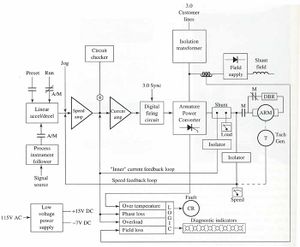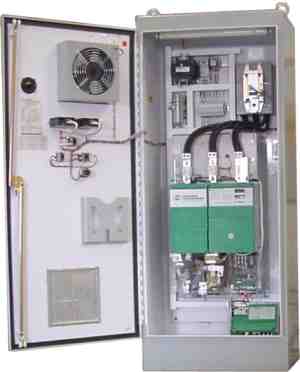DC Drives
DC Drives are DC motor speed control systems. Since the speed of a DC motor is directly proportional to armature voltage and inversely proportional to motor flux (which is a function of field current), either armature voltage or field current can be used to control speed. Several types of DC motors are described in the electric motor article. The electric motor article also describes electronic speed controls used with various types of DC motors.A DC drive is a kind of equipment ordinarily do control a speed, tension and current on a Direct Current Motor (DC Motor), in order to have a certain process transformation under control.
DC drives designed in the 1970s & 1980s combined op amp circuits to provide ramping capability with SCR (silicon controller rectifier) firing circuits to control large voltages. Today, modern DC drives utilize the latest solid-state power-switching technology combined with microprocessors to provide programmable features. When you look at the diagram of a modern DC drive you will notice that much of the circuitry looks similar to an AC drive. The main difference is that the rectifier stage & output stage of the DC drive are combined because the DC drive simply adjusts the DC voltage & current rather than invert it back to AC. Since the output voltage for the drive is DC, SCRs will be used in rectifier circuits. The newest drives have programmable parameters similar to AC drives in that they set the maximum voltage, current, & speed, as well as provide protection against over current, over temperature, phase loss of incoming power, & field loss.
Uses
DC drives and motors remain common in industries such as metals, cranes, mining and printing. The current trend is to replace DC systems with new AC Drives and Drives to reduce maintenance overhead. This can, however, often be a significant task that requires the machinery to be taken out of service for an extended period while mechanical and electrical rework is completed. Utilizing existing DC motors and upgrading the DC drives is often the most attractive option. DC motors are usually well built and capable of offering many more years of service to help lower project costs and minimize disruption and risks. Control Techniques DC drives are now based on our industry-leading AC drive technology to deliver enhanced motor performance, reliability and system integration options.

